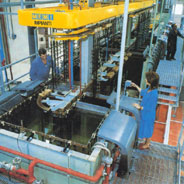




PROCESSES
 |
 |
 |
 |
 |
|||
| SUGGESTIONS | CATALOGUE | MATERIALS
& PROCESSES |
COMPANY | NEWS | CONTACTS | ||
|
|
|
HARD AND MULTI-LAYER CHROMIUM PLATING |
|||||||||||||||||||||||||||
 |
GENERAL DESCRIPTION OF TREATMENT 1. The hard chromium plating process aims at creating a coating of hard and wear-resistant chromium with a thickness of over 3 µm (reaching values over 1000 µm according to requirements) directly on the metal part without the insertion of copper or nickel layers. 2. The multi-layer hard chromium plating process is the application of multiple layers of chromium (from a minimum of two to maximum four), to increase plate corrosion resistance while keeping the mechanical properties unchanged. The process involves the application of a softer non-fissured chromium layer which serves as corrosion protection, followed by the application of a hard chromium layer resistant to wear. The items to be coated are treated in a solution of chrome salts and the metal chromium coating is obtained by means of an electro-chemical reduction process. |
|||||||||||||||||||||||||||
|
|
||||||||||||||||||||||||||||
| COATING CHARACTERISTICS | The characteristics that determine the technical and industrial importance of chromium are: - optimal hardness - low friction coefficient - suitability for applications in severe tribological conditions - non-slip surface - good mechanical workability - high chemical and thermal resistance - good appearance These characteristics enable the use of chromium coatings in a vast range of industrial sectors and make them technically and economically irreplaceable in all major applications. |
|||||||||||||||||||||||||||
| PHYSICAL CHARACTERISTICS |
|
|||||||||||||||||||||||||||
| MECHANICAL CHARACTERISTICS | Chromium plating features high levels of hardness and resistance to wear and it is thanks to these properties that they can be applied in a huge range of sectors. As regards hardness, it must be noted that this is not directly correlated with wear resistance. According to some research, the maximum resistance to wear is around 800-900 Vickers and chromium plating over 1000 Vickers is not recommended due to the excessive fragility caused by internal tension in the coating. However, this must all be evaluated on the basis of the characteristics of the substrate and the type of stress that the product is subject to. |
|||||||||||||||||||||||||||
|
REACTION TO CORROSION
|
Resistance to corrosion of a hard chromium plate depends on the thickness of the coating, adherence and micro-fissures of the latter. This micro-fissured structure is what provides the optimal hardness of the layers. Oxidant or reducing agents have a negligible effect on chromium; however it is susceptible to rapid attack by chloride acid and chlorides in general, and moderate attack by diluted sulphuric and nitric acids . As an example, a steel sheet suitably treated with a 0.5 mm coating should withstand over 150 hours of exposure to saline mist. The use of multi-layer chromium plating is recommended in applications in aggressive atmospheres. |
|||||||||||||||||||||||||||
| COATING DISTRIBUTION AND CHARACTERISTICS | The electro-deposited chromium layer is not uniformly distributed, in particular there are zones such as sharp edges or points where deposits are highly accentuated, while deposits are virtually non existent in holes or in the undercuts. | |||||||||||||||||||||||||||
| FINISHINGS |
The following table illustrates the types of finishings currently possible
|
|||||||||||||||||||||||||||
| COMPATIBLE MATERIALS |
The following materials can be coated after suitable preparation treatments and without intermediate nickel or copper layers:
* cast iron must undergo a sanding treatment prior to application. |
|||||||||||||||||||||||||||
| FRAME DESIGN | To obtain optimal results in terms of coating and chromium thickness distribution a major factor of importance is the setting up of parts on the frames. The frames are designed specifically on a case-to-case basis in collaboration with the client and constructor, to meet the specific demands of the application. |
|||||||||||||||||||||||||||
| DIMENSIONAL CONSTRAINTS | Bettini can currently chromium plate parts with dimensions from a few millimetres (10 – 20 mm) to one metre. Max. Dimensions of cylindrical parts: h = 1000 mm Ø = 300 mm max weight = 300 kg |
|||||||||||||||||||||||||||